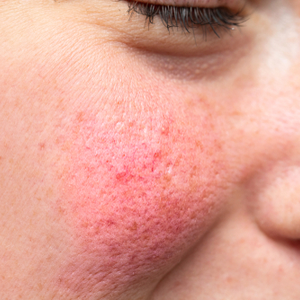
What is erythema?
The term erythema comes from the ancient Greek and can be translated as redness or inflammation. From a dermatological point of view, erythema is a reddening of the skin caused by increased blood flow, for example as a result of vasodilatation or the side effects of medications such as ACE inhibitors. In many cases, erythema fades away on its own after some time. However, in severe cases, treatment under medical supervision is necessary.
What causes erythema?
Erythema is a type of reddening of the skin that is caused by a pathological process that directly affects the skin. Doctors refer to this as primary florescence, which occurs, for example, as a result of various infections and skin diseases. However, erythema can also be caused by other reasons. Erythema pudoris, for example, usually disappears after a few minutes. If the erythema covers more than 90 percent of the body surface, doctors call it erythroderma.
What forms of erythema are there?
In addition to the forms of erythema already mentioned, doctors also distinguish between slice erythema, Stevens-Johnson syndrome and the so-called "scalded skin syndrome":
- Disc rose: occurs mainly on the extremities and face of young people. The disc rose manifests itself as a disc-like, fingernail-sized erythema and is often accompanied by fatigue, joint pain as well as a slight fever. usually a disc rose heals spontaneously after some time.
- Stevens-Johnson syndrome: is accompanied by severe general complaints and is usually triggered by infections that have not healed or allergic reactions. In addition to high fever, many patients also complain of herpes-like blisters, which can appear in both the mouth and genital areas, and conjunctivitis.
- "Scalded skin syndrome" (Lyell's syndrome): takes on life-threatening forms due to the detachment of the entire epidermis of the body, as the protective function of the skin is massively reduced. Lyell's syndrome is usually triggered by severe allergies or by side effects to certain medications.
- Erythroderma: is a special form of erythema and exists when more than 90 percent of the body is affected by the redness of the skin. In erythroderma, the vessels are greatly dilated and the skin is inflamed. As a result, there can be a loss of protein, fluid and salt, which can even lead to life-threatening secondary infections.
What are the symptoms of erythema?
The typical symptom of erythema is reddening of the skin. This can take on different sizes and different colour intensities and occur on the most diverse parts of the body. However, it is often mainly the parts of the body with a strong blood supply that are affected. This includes the chest area, for example, but also the arms or the genital area.
Erythema can be easily distinguished from other skin diseases. This is because when pressure is applied, the redness of the skin can change colour and does not cause pain in most cases. Only as the disease progresses and depending on the causes of erythema can symptoms occur.
How is erythema diagnosed?
Through a thorough physical examination, the dermatologist will determine whether it is erythema, the precursor of eczema or a skin bleed. To do this, the doctor will apply pressure to the affected area of skin to see if it discolours. If the redness of the skin discolours when pressure is applied, even if only for a short time, in most cases it is an erythema.
How is erythema treated?
If the erythema is caused by a bacterial infection, it must be treated urgently, otherwise dangerous symptoms may develop. This includes, for example, a secondary infection of the affected skin areas, which can also radiate to other organs and possibly take on life-threatening forms. Antibiotics are usually used to treat erythema caused by bacteria or fungi. However, it is important to clarify whether there are any allergies or intolerances in order to avoid undesired reactions.
In the meantime, there are also various remedies from naturopathy or alternative healing methods such as ultrasound therapy, cold or heat treatments. These are supposed to help reduce skin redness. However, it is advisable to consult a doctor before using these treatments.
If, on the other hand, it is assumed that the erythema is caused by an unhealthy lifestyle, the patient should change his or her daily habits. The same applies to external influences. Excessive sunbathing, for example, could be avoided. However, those affected should also make sure that clothing is made of skin-friendly materials and, if necessary, avoid skin-irritating perfumes and skin care products.
What are the healing prospects of erythema?
The chances of healing depend on the type of erythema and its severity. If the erythema is caused by a harmless inflammation, it can go away after a few hours or days without medical treatment. If, on the other hand, the erythema is caused by severe skin diseases, it may even take weeks or months for it to disappear. If it is a chronic skin disease, patients will be plagued by recurrent episodes of skin lesions. All in all, however, the prognosis for complete healing of erythema is good.
